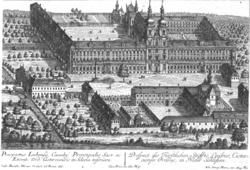Lubiąż
| Lubiąż | ||
|---|---|---|
| Village | ||
|
| ||
| ||
 Lubiąż | ||
| Coordinates: 51°16′N 16°29′E / 51.267°N 16.483°E | ||
| Country |
| |
| Voivodeship | Lower Silesian | |
| County | Wołów | |
| Gmina | Wołów | |
| Population (2006) | 2,300 | |
| Time zone | CET (UTC+1) | |
| • Summer (DST) | CEST (UTC+2) | |
| Postal code | 56-110 | |
| Area code(s) | +48 71 | |
| Car Plates | DWL | |
Lubiąż ([ˈlubjɔ̃ʂ]; German: Leubus) is a village on the east bank of the Odra (Oder) River, in the administrative district of Gmina Wołów, within Wołów County, Lower Silesian Voivodeship, in south-western Poland. It lies approximately 14 kilometres (9 mi) south-west of Wołów, and 42 kilometres (26 mi) west of the regional capital Wrocław. The village has a population of 2,300.
The village is mainly known for its large abbey. The Abbey was built by the Benedictines in 1150, and occupied by Cistercians in 1163 until 1810.[1] Built over centuries, the abbey – the largest Cistercian abbey in the world – is rated in the highest class ("0") of landmarks of world's cultural heritage. Lubiąż is also known in Poland for its regional psychiatric hospital.
History

The village is located on one of the oldest river crossings in Silesia. This crossing was protected by a castle, which was probably destroyed in 1108, and populated by Poles,[2] who lived in a market named Lubies, which was documented in 1175.[3] From the 11th century the settlement belonged to various Silesian principalities ruled by dukes of the Silesian branch of the Piast dynasty.

In the middle of the 12th century an abbey was founded on the place of the former castle. Sources disagree on the exact date and nature of the foundation. While some sources claim the monastery was founded around 1150 by Benedictines and soon after passed to the Cistercians, other sources argue the monastery was founded by Cistercians around 1163. The deed of foundation was ratified in 1175 by Bolesław I the Tall, who chose the abbey as the burial place for him and his dynasty. The monastery was settled with Cistercian monks from Pforta in the Margraviate of Meissen,[4] Bolesław refuge during his stay in Germany.[5] In the same document the duke allowed the monastery to settle their territory with Germans and to exclude them from Polish law, making it the first place of the Ostsiedlung in Silesia.[6] The German small town Leubus[7] was founded on the place of the former Polish market,[8] the place Germanized,[9] and received German town law in 1249.[10]

The region passed to the Crown of Bohemia in 1329 and thus became part of the Holy Roman Empire. On 30 June 1432 the Hussites invaded the village, devastating and burning the monastery. The area was heavily affected by the Thirty Years' War. In 1632 it was plundered by the Saxons, and in 1639 was occupied by Swedish forces. In 1740 Silesia (and so Leubus) was taken from Austria by the Kingdom of Prussia. Municipal law was lost in 1740, and irrevocably in 1844. From 1871 until 1945 Leubus belonged to German Empire, Weimar Republic and finally Nazi Germany. It then passed to Poland along with the bulk of the former Silesia Province (1938–1941); see Territorial changes of Poland after World War II. The German inhabitants were expelled, the village resettled by Poles and renamed to Lubiąż.
References
- ↑
 Herbermann, Charles, ed. (1913). "Leubus". Catholic Encyclopedia. New York: Robert Appleton Company.
Herbermann, Charles, ed. (1913). "Leubus". Catholic Encyclopedia. New York: Robert Appleton Company. - ↑ Weczerka, Hugo, Handbuch der historischen Stätten - Schlesien, Alfred Kröner Verlag, Stuttgart 2003, p.279
- ↑ Adam, Heinrich, Die schlesischen Ortschaften - ihre Entstehung und Bedeutung, Verlag von Pribatsch Buchhandlung, Breslau 1888, p.9
- ↑ Weczerka, p.277
- ↑ Conrads, Norbert, Deutsche Geschichte im Osten Europas: Schlesien, Siedler Verlag, Berlin 1994, p.61
- ↑ Conrads, p.115
- ↑ Weczerka, p.279
- ↑ Weczerka, p.279
- ↑ Conrads, p.115
- ↑ Weczerka, p.279
External links
| Wikimedia Commons has media related to Lubiąż. |
Coordinates: 51°16′N 16°29′E / 51.267°N 16.483°E


